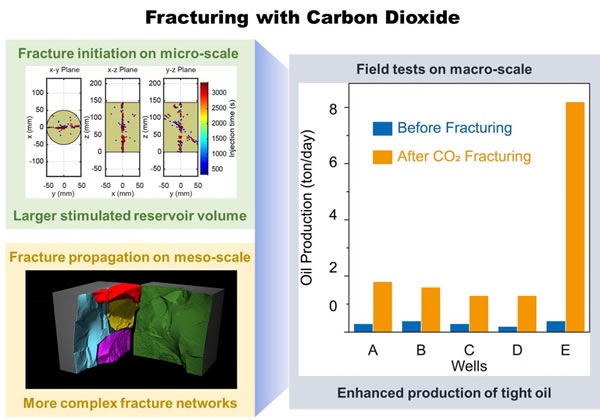
Recently, the Key Laboratory of Low Carbon Conversion Science and Engineering of the Shanghai Advanced Research Institute of the Chinese Academy of Sciences has made progress in the study of the mechanism of multi-scale carbon dioxide fracturing and recovery of unconventional oil and gas resources. Related results were published online in Joule on May 30 (Joule 2019, doi: 10.1016 / j.joule.2019.05.004).
Hydraulic fracturing technology is one of the key technologies for the great success of North American shale gas, but this technology has huge water consumption and significant environmental footprint. Shale gas in China is mostly distributed in water-scarce and arid areas, and the environment is fragile. The demand for waterless fracturing technology is more significant. Among many waterless fracturing technologies, carbon dioxide fracturing is of particular concern and has great application prospects. The technology saves water, reduces fracture pressure, avoids reservoir damage, and increases oil and gas recovery, while geological storage of some carbon dioxide, to achieve green and low-carbon development of unconventional oil and gas resources. However, the lack of in-depth understanding of the unique physical and chemical properties of carbon dioxide on the fracturing behavior is one of the important obstacles to the popularization and application of technology.
Researcher Wei Wei and associate researcher Sun Nannan's team developed an integrated high-temperature and high-pressure fracturing experiment platform for deep condition simulation-pump injection fracturing-in-situ acoustic emission signal acquisition in the past five years The Institute, the Institute of Geology and Geophysics, Chinese Academy of Sciences, China University of Petroleum (Beijing) and other teams conducted a series of carbon dioxide fracturing and hydraulic fracturing shale experiments. Using the acoustic emission data generated during the fracturing process to reproduce the fracture evolution process caused by the injection of fracturing fluid, and through the moment tensor theory analysis of the acoustic emission event, the quantitative analysis of the evaluation fracturing mechanism was realized. It was found that during the process of carbon dioxide fracturing, the mechanism of fracture formation is obviously different from that of hydraulic fracturing. Its low viscosity and high diffusivity characteristics promote the reservoir to develop and accumulate fractures that are mainly shear-type failures, thus reducing fractures. Pressure and form complex seams. Through the digital reconstruction of the fracture surface after fracturing, it is found that the area of ​​the fracture surface of carbon dioxide fracturing is nearly twice that of hydraulic fracturing, indicating that carbon dioxide can effectively communicate more natural fractures, thereby increasing the effective reconstruction volume. The on-site experiment results of the cooperative team show that the output after carbon dioxide fracturing is 4-20 times that before the transformation. This research covers the multi-scale research range from micro-mechanism to macro application, and obtained valuable experimental results, which have significant practical significance for the design of carbon dioxide fracturing and enhanced flooding unconventional oil and gas processes.
The research work was supported by the strategic pilot science and technology project of the Chinese Academy of Sciences, the equipment research and development project of the Chinese Academy of Sciences, the National Natural Science Foundation of China, and the Shanghai Institute of Advanced Research Interdisciplinary Youth Innovation Fund.
Zinc Bibcock And Taps,Zinc Bibcock,Zinc Taps,Zinc Tap Handle
AS-SUR INDUSTRIAL VALVE CO., LTD. , https://www.assur-valve.com